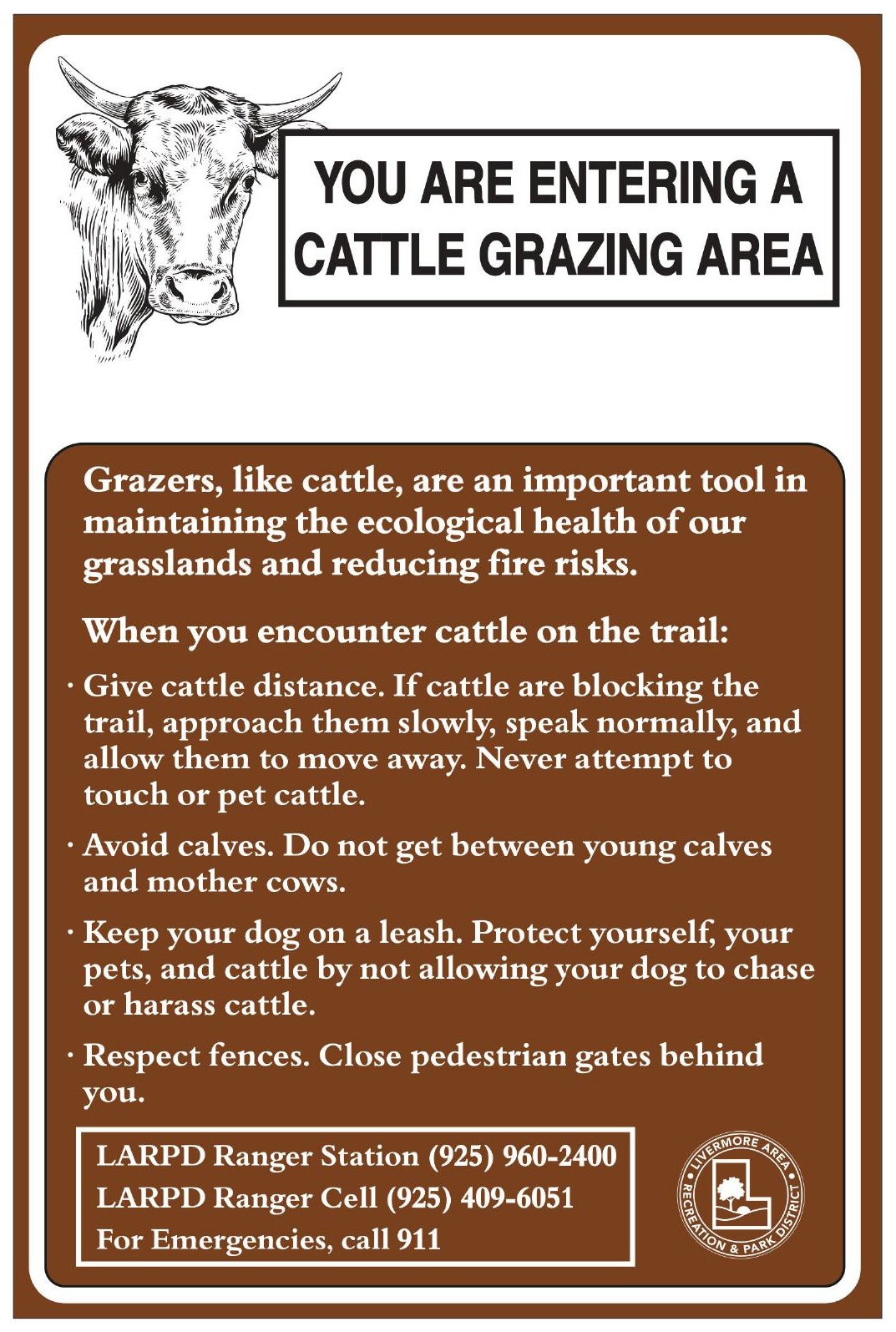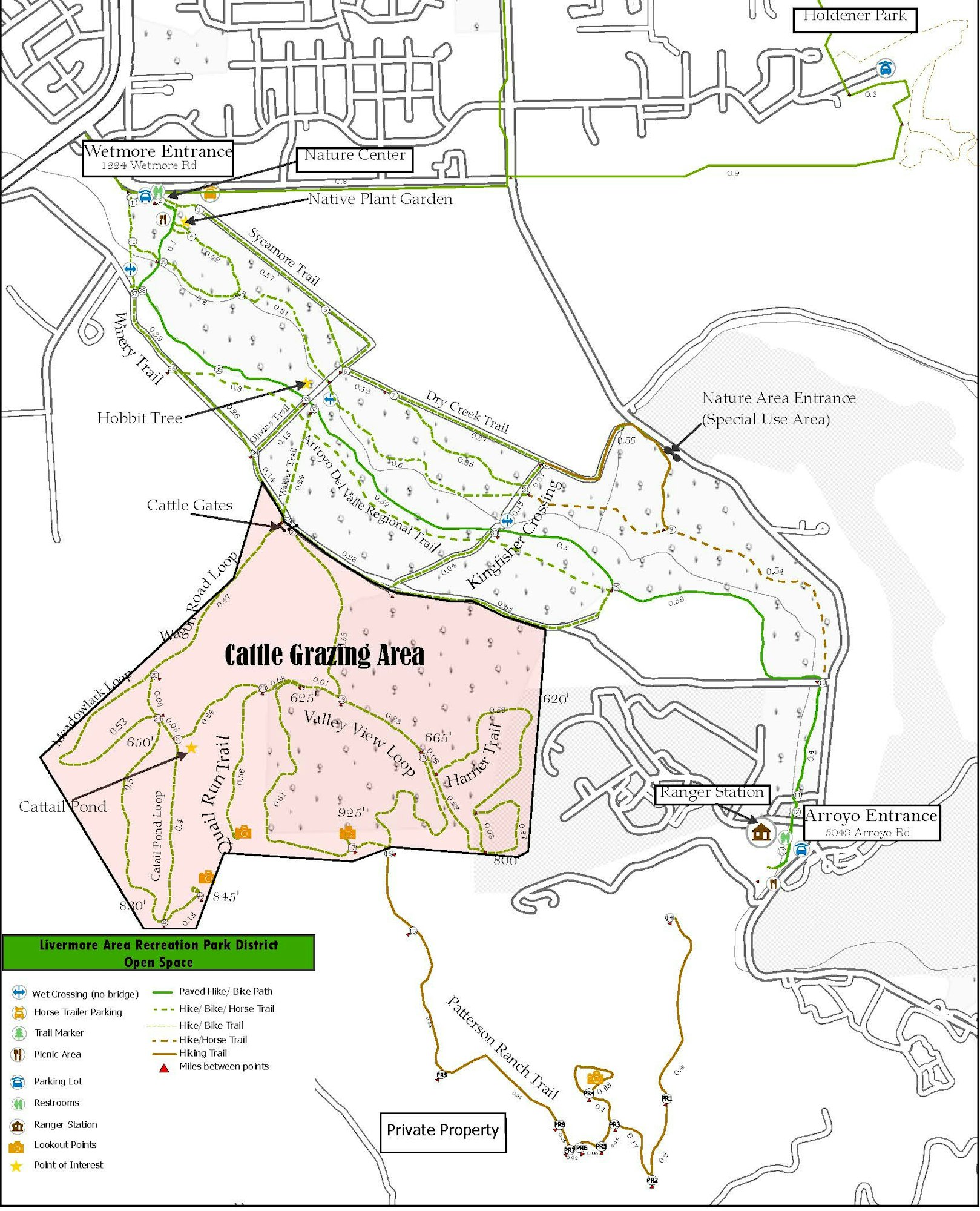Grazing
When you visit LARPD Open Spaces, you may encounter grazers like cattle or goats. Together with mowing and prescribed burns, grazers are important tools in reducing fire risks and managing non-native plants in our open spaces.
What to do Around Cattle
When you encounter cattle on the trail:
- GIVE CATTLE DISTANCE. If cattle are blocking the trail, approach them slowly, speak normally, and allow them to move away. Never attempt to touch or pet cattle.
- AVOID CALVES. Do not get between young calves and mother cows.
- KEEP YOUR DOG ON A LEASH. Protect yourself, your pets, and cattle by not allowing your dog to chase or harass cattle.
- RESPECT FENCES. Close pedestrian gates behind you.

Follow these rules to keep yourself and others (including your furry friends) safe while recreating in grazing areas.
Please Close The Gate Behind You
New cattle gates have been installed in the upper property of Sycamore Grove to corral the cattle, but ALL visitors are welcome! Hikers, bikers, equestrians and leashed dogs are encouraged to come to the area and explore. Please be sure gates are closed and latched fully behind you whenever you enter or leave the property.
Benefits of Grazing
Cattle are here in our open spaces doing very important work!
Fire Protection
Fire is a natural part of California ecosystems, including grasslands. With the loss of native grazers, like tule elk and pronghorn, and the suppression of fire in recent history, dangerous wildfires have become more common. Grazing by cattle reduces "fuel load" of old plant growth and helps reduce wildfire risk.
Habitat Conservation
Cattle ponds provide breeding habitat for threatened amphibians, like California Red-legged Frogs and California Tiger Salamanders, while cattle themselves make it easier for these critters to access these ponds by trampling and eating surrounding vegetation.
Invasive Plant Management
Much of California's grasslands are now dominated by non-native and invasive plant species. Grazing cattle can help keep these plants in check, allowing native grassland plants to flourish.
Sycamore Grove Park| Upper Livestock Grazing Management Zone

FAQ
Properly managed cattle grazing is good for open space and our grasslands. Their grazing reduces wildfire risk, helps our native plant species, and helps threatened species like Red-legged Frogs and California Tiger Salamanders.
Large grazers, like tule elk and pronghorn, were historically all throughout California; cattle today can help fill that niche in the ecosystem. Learn more about the history of grazers and grasslands in California in this Valley Wilds article.
Cattle are big livestock animals. While not aggressive by nature, they can be dangerous if startled or provoked. Like wild animals, they should be treated with respect. There are things you can do to keep yourself (and your dog if you have one) safe while hiking in grazed areas.
Cattle are usually on the land grazing during the growing season, which could be from October to June. In the beginning of this pilot program, cattle may be at the park year round until the grasslands are grazed down to a manageable level. LARPD and the ranchers work together to see how long the cattle should be in the park.
This is a pilot program for LARPD and we'll be evaluating the impacts for the first few years.
Cattle may be found seasonally at:
- Sycamore Grove Park in the upper property
- On the north side of Brushy Peak
- Along the Patterson Ranch Trail in Zone 7's property
Goats may be found seasonally at:
- Robertson Park along the Arroyo Mocho
Around Cattail Pond, plants like cattails, tule, willows, and coyote brush are being cleared out as cattle graze and trample to get to the water.
- These plants, when left unchecked, may otherwise damage the pond's dam. Cattail Pond as it is today is a human-made restoration project and LARPD has obligations to maintain it. The difficult work of removing these plants to prevent damage, which was historically done by Open Space Rangers, is now being tackled by the cattle.
- Less plants around the pond's edge create better access to the water for threatened native species like red-legged frogs and western pond turtles, who use the pond for habitat and to breed.
- Not all of Cattail Pond will be grazed; cattle fencing was installed along the upper part of the pond and upstream to keep cattle out.
Sometimes cows and/or calves can become sick or injured. If you see a cow or calf that is in distress, please call the ranger station at 925-960-2400 or the ranger cell at 925-409-6051. If possible, while staying at a safe distance, take a photo of the animal; if the animal is tagged, take note of the number on the tag. Ranger staff will let the rancher know about these reports.
In the case of mother cows, there is a chance you could witness a birth or a cow who has recently given birth. Sometimes, these cows may need to rest after giving birth, or may have complications from the birth. If it looks like the cow is in distress, please let the ranger station know.
Baby cows, or calves, may be seen when visiting Sycamore Grove Park. During calving season, it is especially important to follow all posted signage about recreating around cattle. Mother cows can be especially protective of their babies. Do not get between a mother cow and her calf. Do not attempt to touch any cows or calves. If you see a calf on its own, mom is likely nearby.
If you find a calf on its own, don't worry. Mother cows will leave their babies bedded down in the grass to go eat food or drink water. Often mom is not far away from their babies. Mother cows need breaks, too!



